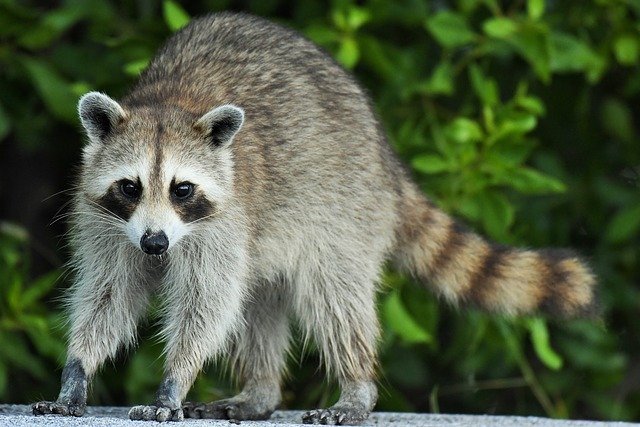Raccoons Can Jump How High And How Far
Raccoons, sometimes known as garbage pandas or nature’s bandits, may seem to be charming and cuddly, but they are much more than they appear on the surface.
You may describe them as either a charming guest who moves from place to place or a pest that causes havoc on someone’s property, depending on who you talk to.
Knowing more about raccoons may help us all understand what they do and why they do it. We are typically aware that they are scavengers, hunting for safety and food in the same way that everyone else in nature does.
But, frankly, what more do we know about them? Here are a few facts about the raccoon that may help you have a better knowledge of the animal as a whole.
What is the height of their jumps?
The response is “not very high” in terms of real vertical leaping ability. They have short, stubby tiny legs, and in the wild, they tend to be fairly hefty. Because of these constraints, they are only able to leap a limited distance straight up.
They are only capable of vertical leaps of a couple of feet, at most four feet. Despite the fact that their bodies aren’t designed for that type of physical jumping ability, they adapt by making the most of their circumstances.
In other words, if you notice one in your yard and are perplexed as to how it got there, there’s a strong probability it didn’t get there by jumping over anything. Because of their agility, they’re far more effective at leaping off objects than they are at jumping over them.
So, let’s try rephrasing the question a little bit.
Raccoons Can Jump How High And How Far
What is the maximum distance they can jump/fall?
This is a far more appropriate question to ponder. A raccoon on your roof or the top of a nearby house is likely to have piqued your curiosity, and you may have wondered how something so small and stubby could manage to achieve such a difficult feat.
The explanation is that raccoons are excellent jumpers as well as climbers, which makes them a formidable combination.
The distances they can leap are three to four feet either vertically or laterally if they can reach to a high point such as a tree or other elevated structure.
Because of their frame, they are limited in their capacity to jump high; yet, the distance they can jump from is astounding given their size.
There seems to be widespread agreement that raccoons are capable of jumping from heights of up to 40 feet in the air with ease. As a result, when they manage to land on the roof of a house, it is because they are able to climb into some of the tallest trees and jump to the top from there.
The fact that they can jump from such great heights without being injured is very astounding. Even if they do fall, it may not be the end of the world, since their stubby tiny legs provide the ideal platform for landing softly from typical heights in a landscape.
Because of their climbing and jumping abilities, as well as their overall intelligence, raccoons are able to get access to a wide variety of environments that most other animals in the wild are unable to reach. It is for this reason that they are such hardy survivors, and it is also for this reason that they may be a very tough pest issue to deal with.
Raccoons are excellent climbers, and they can scale walls and trees.
While it may come as a surprise that raccoons can fall safely from such a great height, it should come as no surprise that they are excellent climbers. Because of their claws and leaping range, they can easily climb most fences and homes without any difficulty.
Moreover, they have proved to be highly effective in climbing up items such as gutters and rain spouts, in some cases causing damage to these structures as they ascend.
Given that its name derives from a rough translation of the phrase “beast that scrapes with its hands,” it stands to reason that their claws are one of their most prized qualities. They are also quite tenacious, maintaining their position if they believe that the location has a rich supply of food, which they often do.
The presence of raccoons digging in your yard, whether it is around a fence so that they may get in or at a projected food supply, is not unheard of. There are six separate species of raccoons in North and South America, however they all have comparable characteristics in terms of claws and behaviors, making them distinct but similar in their appearance.
Their Distinctive Appearance
Perhaps the most well-known characteristic of raccoons is their distinctive appearance. The black covering over their eyes spreads out, giving them the appearance of a bandit’s mask.
It’s no surprise that they’ve gained the moniker “nature’s bandits” as a result of their innate scavenging talents and other characteristics.
But did you know that the infamous “black masks” have a natural function in addition to their eerie appearance? They assist the raccoon in seeing more clearly and plainly. The same way that eye-black works for sportsmen, the blackness of their fur works for them as well.
The dark hue aids in the absorption of light as it travels toward the raccoon’s eyes, decreasing the glare that would have otherwise been visible to him. It is possible that the glare may cause a blockage, so lowering the overall quality of eyesight.
Because raccoons are most active at night, there is less peripheral light available to them. When combined with their black fur, this makes it more simpler for them to perceive the contrast that exists between the thing they are focused on and the background.
This is one of the most important characteristics for seeing well at night.
The number of people living there is increasing.
Generally speaking, the expansion of the human population has had a negative impact on numerous species and their populations throughout the course of history.
It is the raccoon, on the other hand, that has seen a significant increase in population during the previous few of decades. These achievements are made possible in spite of the devastation and destruction of the raccoon’s natural environment.
This is partly due to the fact that raccoons are very adaptive. They may flourish in a variety of environments, including urban, rural, and suburban settings.
They are most often seen in residential areas feeding on pet food that has been inadequately kept and trash cans that have not been securely locked. However, in a woodland area, they may survive on insects, birds, nuts, fruits, and seeds, among other things.
They are, without a doubt, one of the most adaptable species on the planet. No matter what their surroundings demand, they always find a way to make it work.
That is the fundamental reason why the raccoon population has continued to grow despite the natural consequences of increasing human populations on the planet.
Raccoons in urban areas may really be more intelligent than their counterparts in rural areas.
Raccoons are often considered to be extremely clever creatures by members of the scientific community, and this is generally true. However, depending on their environment, there are significant variances in the way kids learn.
While “country” raccoons, those who live in thickly forested areas, are typically intelligent, the “city” raccoon has a distinct set of problems that are more diversified.
This is mostly due to the fact that the “city” raccoon has the additional human factor. For this reason, although human-made hurdles may not be as prevalent in the woods, they are abundant in an urban context, and the raccoon is required to adapt to and outwit these obstacles on a daily basis in order to get food or shelter.
Several studies have even shown that raccoons have learnt to avoid busy crossroads, according to the researchers. Those same studies have also shown that urban raccoons may be more adaptable than their country counterparts when it comes to opening trash can lids, which is a key source of food for them.
Put another way, raccoons are highly adaptable and clever survivors who can make the most of any circumstance or environment. The greater the number of difficulties they encounter, the greater the likelihood that they will overcome those difficulties and achieve their objective.





